- 05 Oct 2025
- 13 Minutes to read
- Print
- DarkLight
Job Code Default Data (JCDD) Import Overview
- Updated on 05 Oct 2025
- 13 Minutes to read
- Print
- DarkLight
Abstract
Product: Infinite BrassRing and Workbench.
JOB CODE DEFAULT DATA (JCDD) OVERVIEW
The Job Code Default Data (JCDD) function allows your organization to associate a set of req field default values to a Job Code. This is useful to organizations that want to ensure that the proper values are auto-populated in fields when users select a Job Code to start the requisition creation process. There are three ways you can update or maintain Job Code Default Data (JCDD) in BrassRing.
Warning
If Job Code Default Data populates the parent of a Req Field Association (RFA), then the child field will not be defaulted.
Manual updates through BrassRing. For more information, see Manage Job Codes.
JCDD Import Integration (Position Data Import). JCDD can be kept up-to-date through an integration with your HRIS or system of record.
JCDD Excel Import by using Workbench. This option is available for Workbench users with Power User access or for users that have Tier 5 access with the proper client setting enabled. The steps to successfully update JCDD by using a Workbench import are covered in this documentation.
PREPARING THE SPREADSHEET FOR IMPORT
It is recommended to always obtain the properly formatted spreadsheet before completing your Job Code Default Data (JCDD) import in Workbench. To do this:
Export the JCDD: Tools → Forms → Reqs → Req Forms. Administer req fields for the req template you’d like to import the JCDD for and select Export Job code defaults to Excel.
Only Active job codes are exported. Updated Build 19.08.19.
Fields with the field type Label are excluded from the export. Updated Build 19.08.19
Select Tools → Task Manager to retrieve your export and open the file. Save it to your computer as an Excel file type (.xls)
Your import spreadsheet can only have two tabs: Properties & Defaults. Do NOT change the name of the tabs
You do not need to make any changes to the Properties tab
As with all configuration and import tasks in Workbench, it is recommended that customers first complete the work in Staging before making any updates in Production. This helps you identify and resolve any potential issues before completing the task in your Production environment.
The export includes both active an inactive job codes. Delete the rows for codes you are not updating.
You must include the job code column and the columns for the fields you are updating.
For fields that have options, put the option code in the import spreadsheet. Any option that you would like to default must be in the option list before you import the spreadsheet otherwise you receive an error for that row.
Sample JCDD Import Spreadsheet Format
Properties Tab:

Defaults Tab:

IMPORT JOB CODE DEFAULT DATA (JCDD) (POWER USER)
Abstract
Product: Workbench
Relevant eLearning
Process
Export the current Job Code Default Data by selecting Tools → Forms → Reqs → Req Forms then select to Administer the fields for the req form to pull the JCDD for.
Select Export job code defaults to Excel.
Access the Task Manager by selecting Tools → Task manager.
Prepare your spreadsheet by adding or modifying the JCDD that you would like to import.
Select Tools → Import → Profiles.
Create a New Import Profile or use an existing Import Profile to import your spreadsheet:
Creating a new Import Profile
It is not required that a new profile is created every time there is an import to run. It is recommended to create one profile per Import Type.
Select Add new profile.
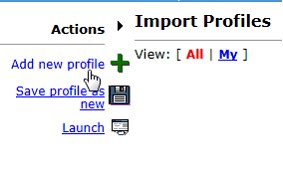
Complete the Import Profile page.
Name your Profile. This can be anything that you would like, but it is recommended that you name the profile the type of import you are planning to run (1).
Select Sharing if you would like other Workbench users to see your Import Profile (2) .
Select Job Code Defaults (3) .
Select the Req form that you would like to apply your JCDD to. JCDD is per req form. If your organization has multiple req forms, to apply the changes to all req forms you must complete the import multiple times, selecting the different req template each time (4).
Select your file (5).
Select Next (6).
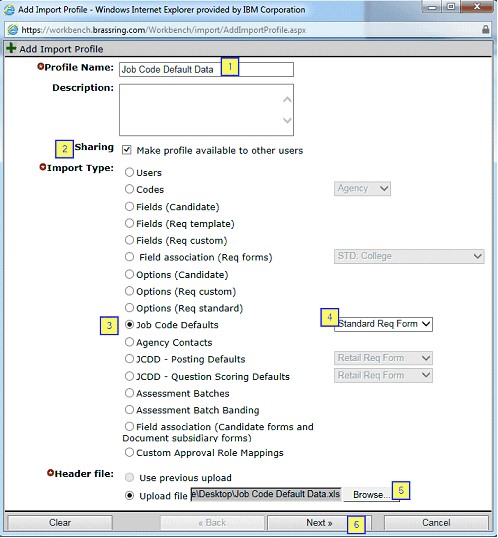
Complete the Map Import Profile page.
The Column Name column shows the fields that are currently present on your req form (1).
The Map To column shows the column headers that are present in your excel sheet. It is recommended to review the Map To column to ensure that there is a column header for each of the fields on your req form, specifically for those fields that you want to add or modify default data for. As mentioned previously, it is recommended that you do an initial export of the current JCDD to get the layout needed to be imported. Having the proper column headers on your spreadsheet ensures that your Map To column aligns with your current req fields (2).
The Overwrite column is used to select the fields to overwrite the JCDD data for. Selecting All checks each box automatically (3).
Select Finish (4).

If you would like to complete the Import process select Launch. If you would like to come back later to complete the steps, select Close.
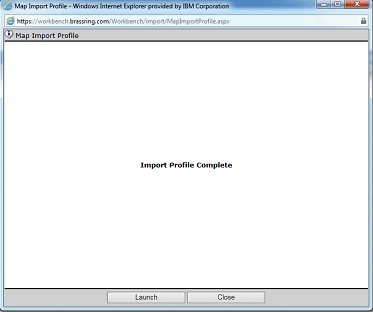
Selecting Launch opens the Launch Import Profile window.
Because JCDD is per req form, select the Req Form to apply this JCDD to.
Reselect your spreadsheet.
Select Launch.
The system processes the spreadsheet and sends you an email when the import is complete. See Completing the Process to continue.
Launching an existing Imp\ort Profile
It is not necessary to create a new profile every time there is an import. It is recommended to create one profile per Import Type. Should you already have an import profile that is created, double check the settings and the mapping of the profile and use that for your future imports.
Select the existing profile and select Launch.

Selecting Launch opens the Launch Import Profile window.
Because JCDD is per req form, select the Req Form to apply this JCDD to.
Reselect your spreadsheet.
Select Launch.
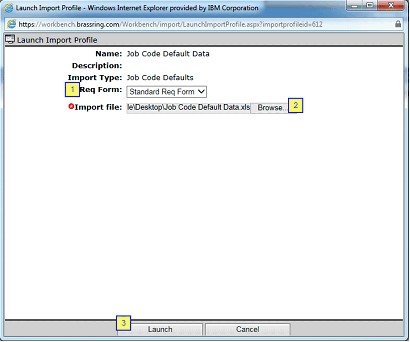
The system processes the spreadsheet and sends you an email when the import is complete. See Completing the Process to continue.
Completing the process
Select Tools → Task Manager.
On the Task Manager page, there is a Status column that indicates the status of your import. There are five potential Statuses you can encounter:
Pending. The import is waiting in line to be processed.
Running. The import is being processed. You can select Refresh display link to watch the progress. The number of rows increases as the file is processed.
Completed. The import has completed without errors. However, it is important to open the file by using the binoculars icon to review the results.
Completed with Errors. The import has completed and has errors that need to be resolved. Open the results file by using the binoculars icon, review the errors, correct them in the original file and reload the file. You can reload the entire original file, with the corrections, or just the JCDD that had to be corrected.
Failed. The import failed completely. This can be an issue with the extension of the excel file that you attempted to import, an overall system error or issue, or that the file was too large and timed out. See Reading the Results file and Common Errors for more information.
IMPORT JOB CODE DEFAULT DATA (JCDD) (TIER 5)
Abstract
Product: Workbench
Process
If you are a Workbench Tier 5 user and do not have access to import spreadsheets in Workbench, put a request into your Infinite representative to enable the setting for your account and add some public profiles to enable successful imports.

Export the current Job Code Default Data by selecting Tools → Forms → Reqs → Req Forms. Select to Administer the fields for the req form to pull the JCDD for, and select Export job code defaults to Excel.
Access the Task Manager by selecting Tools → Task Manager to access your spreadsheet.
Prepare your spreadsheet by adding/modifying the JCDD that you would like to import.
Select Tools → Import → Profiles.
With Tier 5 access, you do not have the ability to create Import Profiles, this must be completed by an Infinite representative. If you do not see a Job Code Default Data Import Profile, contact your Infinite representative to have one added. If you do have one available, continue this process.
Selecting Launch opens the Launch Import Profile window.
Because JCDD is per req form, select the Req Form to apply this JCDD to.
Reselect your spreadsheet.
Select Launch.

The system processes the spreadsheet and sends you an email when the import is complete.
Select Tools → Task Manager.
On the Task Manager page, there is a Status column that indicates the status of your import. There are five potential Statuses you can encounter:
Pending. The import is waiting in line to be processed.
Running. The import is being processed. You can select Refresh display link to watch the progress. The number of rows increases as the file is processed.
Completed. The import has completed without errors. However, it is important to open the file by using the binoculars icon to review the results.
Completed with Errors. The import has completed and has errors that need to be resolved. Open the results file by using the binoculars icon, review the errors, correct them in the original file and reload the file. You can reload the entire original file, with the corrections, or just the JCDD that had to be corrected.
Failed. The import failed completely. This can be an issue with the extension of the excel file that you attempted to import, an overall system error or issue, or that the file was too large and timed out. See Reading the Results file and Common Errors for more information.
READ THE JCDD IMPORT RESULTS FILE AND COMMON ERRORS
Abstract
Product: Workbench
Reading The Results File
The results of your import can be viewed by selecting the binoculars icon. The spreadsheet is broken down into various tabs.
Properties Tab: This tab houses information about your import.
(1) This section contains your “Client Name”, the “Req Form” you loaded this JCDD for, the name of the import profile, the environment, and the user that imported the file.
(2) This section houses the statistics of your import. How many new JCDD values (Inserts), how many updates to existing JCDD, how many JCDD rows errored out, how many duplicate rows were found, and total rows processed. Each of these statuses are broken down further in the additional tabs.
(3) This section shows when the import was submitted to the Task Manager, when it was started, and when it was finished.
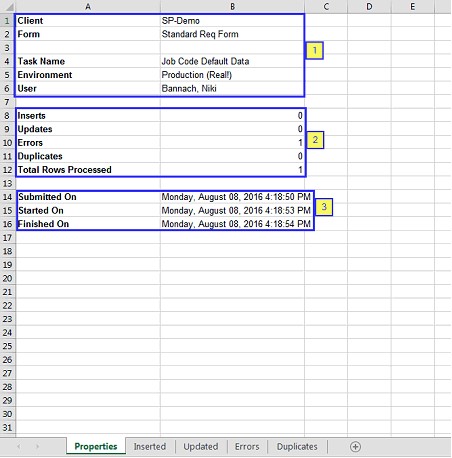
Inserted Tab: This tab shows the JCDD that was processed as ‘new’ and therefore inserted into the BrassRing system.

Updated Tab: This tab shows the JCDD that was found to exist in BrassRing and therefore have been updated.

Errors Tab: This tab is critical to review as it houses any JCDD that did NOT process due to an error. There is an extra column added to the end of this page that displays the detailed reason.
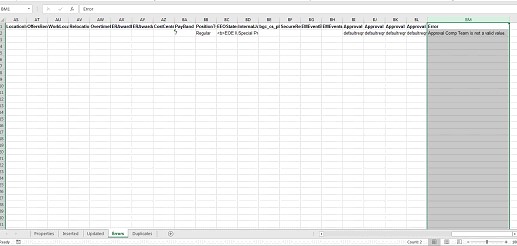
Duplicates Tab: This tab shows any duplicate JCDD rows that might have been in your import spreadsheet. It is important to review the content of this tab as any JCDD that is shown has NOT been processed.

Common Errors and Resolutions
[Field Name]: Codes must contain alphanumeric characters. The only permitted non-alphanumeric characters are dash (-) and underscore (_). A code might not start with a dash (-).
CAUSE: The field contains an invalid character. Only alphanumeric characters, dashes, and underscores are allowed.
RESOLUTION: Remove any non-alphanumeric characters (except for dashes and underscores) from that field.
[Field Name] is not a valid value
CAUSE: The option provided for the field does not exist in the option list.
RESOLUTION: Add the option to the field’s option list and reimport your spreadsheet.
[Field] Input string was not in a correct format.
CAUSE: The data that is entered for the field does not match the field type.
RESOLUTION: Review what was entered for the field and confirm that it matches the field’s field type. For example, if the field is a numeric field but you have entered a special character ($, #, etc) with numeric characters, or if you have added alphabetic characters. Remove any characters that do not match the field’s field type restrictions.
Approval [Approval group name] is not a valid value.
CAUSE: The Approval Group listed is not valid.
RESOLUTION: Check that the Approval Group exists and is spelled correctly. Note: Exporting out JCDD may automatically add a “Defaultreqnoselection” value in the approval groups columns if no default has been set up for that job code. To resolve this issue, clear this value from the rows and re-import.
[Option] is not a legal value for WorkLocation (English (US)).
CAUSE: The option provided for the field does not exist in the option list.
RESOLUTION: Add the option to the field’s option list and re-import your spreadsheet.
External table is not in the expected format
CAUSE: The file that is attempting to be loaded is not in the proper format.
RESOLUTION: Go back to your file format. Compare your file with a file just exported from Workbench, reviewing the tab names to ensure accuracy and the column headers on the Defaults tab. If no differences are found, it is recommended to copy and paste your information into a new spreadsheet and attempt the import again. If that does not work, save your Excel spreadsheet as an ".xlsx" doc then manually go into your files and edit the name, removing the "x" to make it ".xls", then import again.
Form specified does not match the import profile
CAUSE: There is unsupported HTML tags in a field within your spreadsheet.
RESOLUTION: Remove any unsupported HTML in the Job Description field.
The conversion of a nvarchar data type to a datetime data type resulted in an out-of-range value. The statement has been terminated.
CAUSE: Date format is incorrect.
RESOLUTION: Review your date fields and ensure that the format is correct (MM/DD/YYYY)
Conversion failed when converting date and/or time from character string.
CAUSE: Date format is incorrect.
RESOLUTION: Review your date fields and ensure that the format is correct (MM/DD/YYYY)
No. of Positions must be a whole number.
CAUSE: The No. of Positions field has something other than a numerical value.
RESOLUTION: Update the No. of Positions field on the spreadsheet to include only numerical values.
['Defaults$' OR 'Properties$'] is not a valid name. Make sure that it does not include invalid characters or punctuation and that it is not too long.
CAUSE: The file is missing the appropriate tab(s) or the tab(s) are not labeled properly.
RESOLUTION: The file must have 2 tabs, a Properties tab and a Defaults tab. Make sure that your spreadsheet has these tabs and they are appropriately labeled.
Property ‘client' does not match the import file
CAUSE: On the Properties tab, the client name entered is not correct.
RESOLUTION: On the Properties tab, correct the spelling or format of the client name. Exporting the current JCDD and keeping the Properties tab as-is will prevent this error from occurring.
[Field] cannot contain restricted ASCII characters
CAUSE: The field indictated in the error contains ASCII characters; which must be removed.
RESOLUTION: The field must be updated to remove the ASCII characters. (ASCII stands for American Standard Code for Information Interchange. Computers understand numbers, so an ASCII code is the numerical representation of a character such as 'a' or '@' or a computer action of some sort.) You can attempt to copy/paste into a notepad to remove the characters and then paste into the spreadsheet. Manually removing the characters may also work if you are aware of the characters causing the error.
Object reference not set to an instance of an object.
CAUSE: Typically, this error results from system issues, not related to your import/export.
RESOLUTION: We recommend waiting 5-15 minutes and trying the import/export again.
Error converting data type varchar to int.
CAUSE: Field Headers are missing in the spreadsheet.
RESOLUTION: When uploading the JCDD spreadsheet your column headers (containing field names) must match exactly to what is exported originally from Workbench. The first way to resolve this is to match the column headers that are being imported to what is exported from Workbench. Another way to resolve this is to use the “Overwrite All” option on the mapping page. This will bypass the matching column header requirement (skipping the unmatched columns).
More than one record matched criteria.
CAUSE: Field Headers are missing in the spreadsheet.
RESOLUTION: When uploading the JCDD spreadsheet your column headers (containing field names) must match exactly to what is exported originally from Workbench. The first way to resolve this is to match the column headers that are being imported to what is exported from Workbench. Another way to resolve this is to use the “Overwrite All” option on the mapping page. This will bypass the matching column header requirement (skipping the unmatched columns).
